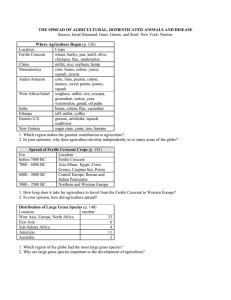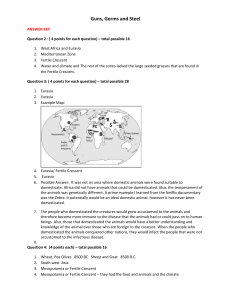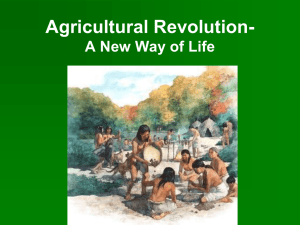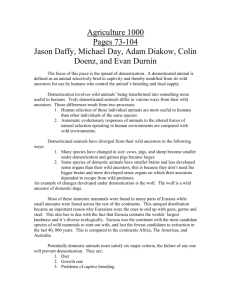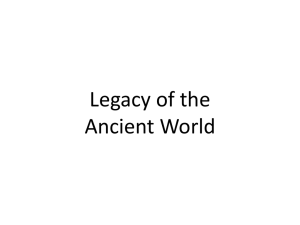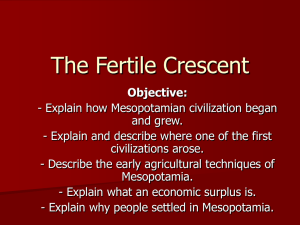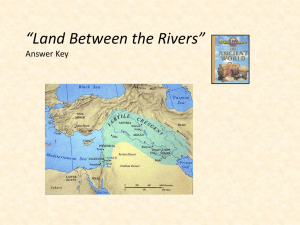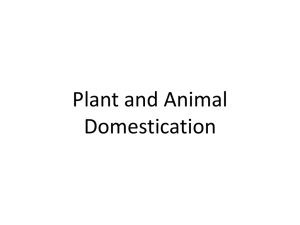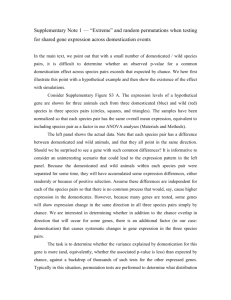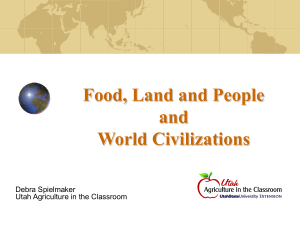Domestication
advertisement
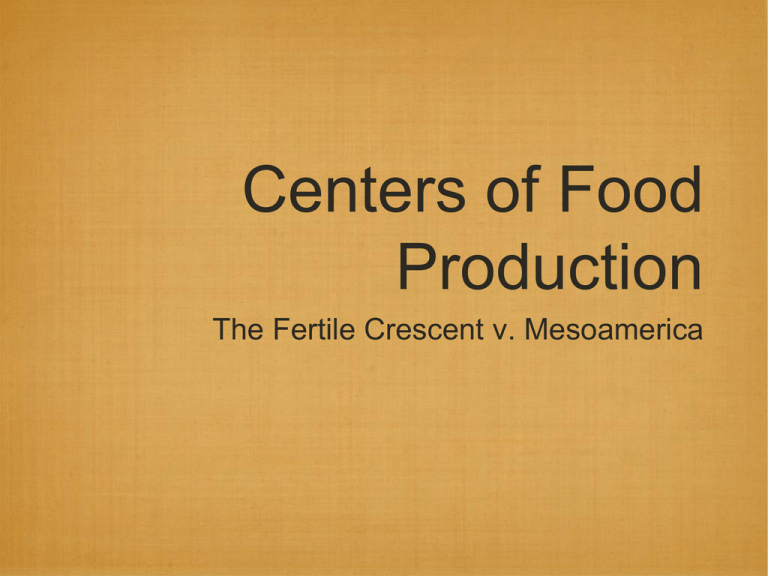
Centers of Food Production The Fertile Crescent v. Mesoamerica Summary We know that in order for societies to become complex and technologically advanced they must develop agriculture. “surplus leads to specialization” Summary To find areas where food production began, we look for the oldest known domesticated species. Domestication is the process of modifying a wild plant or animal (whether we know it or not) to suit humans needs. This process eventually leads to conscious, planned farming of the domesticated species. Summary We Know That there are a number of areas across the globe where food production arose independently. Centers of Food Production Dates of Food Production Fertile Crescent 8500 BC China 7500 BC Mesoamerica 3500 BC Andes and Amazonia 3500 BC Eastern US 2500 BC Independent Ag?? • Sahel Region 5000 BC • Tropical West Africa 3000 BC • Ethiopia • New Guinea ? 7000 BC Fertile Crescent vs Mesoamerica The Fertile Crescent has more wild plant and animal species that are suitable to domestication Wild Plants When we discuss how suitable a plant is to domestication, we are referring to how easily it can be altered to suit human needs. Wild Plants Plants that are more suitable for domestication are those which are useful to humans and can easily be cultivated in their wild form. Fertile Crescent Plants By the Numbers: Of thousands of wild grass species, there are 56 with seeds (grains) that are large. 33 of those are found in Eurasia. 5 are found in Mesoamerica. Large-Seeded Grass F.C. Plants Advantage #1: Wild plants are adapted to the Mediterranean climate. They are Annuals. Annuals have a one-year life. They put their energy into large seeds. Seeds are adapted to remain dormant during dry season - easy to store. F.C. Plants Advantage #2: Wild plants were already abundant and highly productive. Few additional changes needed to be made under cultivation (changes in seed dispersal/ germination inhibitors) Mesoamerica - Staple crop = corn. Corn’s wild ancestor, Teosinte, had to undergo a number of changes to be productive and useful. Teosinte v. Corn F.C. Plants Advantage #3: Self-pollinating Crops Prevents the loss of mutations/inherited advantages The first 8 crops domesticated in the fertile crescent were all “selfers” Wheat The most significant cereal crop from the F.C. Additionally, Wheat has a high nutritional value: 814 % protein Corn The most significant cereal crop in Mesoamerica Lower nutritional value in terms of protein. F.C. Food Package 3 major cereal grains, four pulses (edible seeds from pod-bearing plants), four large domestic animals (used first as a meat source, but later used for transport, fiber, work, and milk), and flax as a fiber and oil source. Mesoamerica Staple crop is difficult to domesticate and slow to develop. Domestication doesn’t occur until approximately 3500 bce, compared with 8500 bce in the Fertile Crescent. Domestication of Animals Domesticated animals Used for their: Meat Milk Fiber Work Domesticated Animals Humans select for traits that benefit us We control their breeding and feeding The Ancient Fourteen 14 species of large, herbivorous, domesticated animals Nine are only used in certain parts of the world Five are widespread and called the “Major Five” Water Buffalo Reindeer Donkey Llama and Alpaca Arabian Camel Bactrian Camel The Big Five Horse Cattle Goat Sheep PIGS! Candidates Fertile crescent The fertile crescent had more candidates for domestication that were suitable for domestication. Mesoamerica lacked candidates and organisms that were suitable for domestication. Why not domesticate the others? “Domesticable animals are all alike; every undomesticable animal is undomesticable in its own way.” Diamond shows that animals must have the following 6 qualities to be domesticable. Lacking any one make them undomesticable. Diet Primarily Herbivorous Otherwise, too much energy is put into gain Ex. 10,000 lbs. of corn to grow 1,000 lbs. of cow vs. 100,000 lbs of corn used to grow 10,000 lbs of cow to feed and grow 1,000 lbs of carnivore. Growth Rate Must be fast growing and reach maturity quickly. Ex. Gorillas and elephants slow growth make them undomesticable Captive Breeding The animals MUST be able to breed in captivity. Animals that need huge amounts of time or space or privacy to breed will not be suitable for domestication. Nasty Disposition Tendency of certain species to kill humans excludes them from domestication. Example: Grizzly bears, Zebras, a number of Equids. Tendency to panic Animals must be calm enough to be around humans ad large groups of their own species. Panicky animals will kill themselves or others trying to escape or run away. Social Structure They must have a social structure that allows them to live with other animals and Ideally, a social structure that humans can put themselves at the top of. Benefits of animals Immunity intensive livestock production involves germs Working around these organisms provides immunity to these diseases People that lack intensive livestock production also lack immunity to animal pathogens (germs) Ultimately... “Peoples of the Fertile Crescent domesticated local plants much earlier. They domesticated far more productive or valuable species, domesticated a much wider range of types of crops, developed intensified food production and dense human populations more rapidly, and as a result entered the modern world with more advanced technology, more complex political organization, and more epidemic diseases with which to infect other peoples.”

